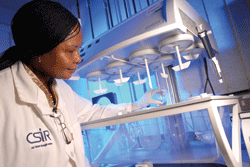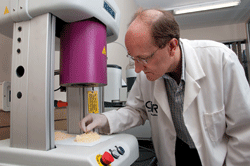
Building South Africa's innovation ecosystem
by Catherine Jewell, Communications Division, WIPO

Dr. Sibusiso Sibisi, President of
South Africa's Council for Scientific
and Industrial Research (CSIR) is a
member of the Advisory Board to
the Global Innovation Index
co-published by INSEAD and WIPO.
South Africa's Council for Scientific and Industrial Research (CSIR), a leading scientific and technology research, development and implementation organization, is at the forefront of the country's quest to become a fully-fledged knowledge-based economy. WIPO Magazine recently met with the CSIR's President, Dr. Sibusiso Sibisi, to find out more about the organization's approach to innovation and the opportunities and challenges it faces in fostering a culture of innovation to deliver widespread economic and social benefit.
The CSIR is a multidisciplinary organization responsible for generating new knowledge, applying existing knowledge, and developing and leveraging technologies to generate positive socioeconomic impact in line with national priorities. “While we quite rightly speak about innovation as a means of stimulating economic growth, our innovation efforts must seek to improve the lives of all South Africans,” Dr. Sibisi stresses.
“We have high levels of youth unemployment in South Africa and huge disparities in wealth, so we need to constantly think about how our innovation strategies can help address these deep-rooted social problems,” he observes. “When I speak of innovation, I am speaking not only of economic growth but also of lifting people out of poverty. I am not just talking about setting up a company that employs people, but about creating an enabling environment where people use the innovation process to set up their own companies.”
The CSIR's role
The CSIR plays a key strategic role in shaping the country's research and development (R&D) agenda. It places great emphasis on catalyzing the development of as yet non-existent or nascent industrial sectors to fully realize South Africa's innovative potential and achieve sustained economic growth. “Rather than short-term employment-creation projects, our role is to undertake R&D and technology transfer that will stimulate sustainable industrial activity and job creation in the longer term,” Dr. Sibisi explains. In this respect, the CSIR is not necessarily driven to maximize commercial returns by licensing technologies offshore. Instead, it seeks to identify and develop technologies with the potential to create local enterprises, generate long-term employment and respond to local needs.
Serving economic and social interests
The organization seeks to address industrialization at every level, working with groups at the grass roots as well as those in high-tech spheres. For example, it is working with small farmers to develop the production of essential oils for the fragrance industry in France. “The kind of support we are providing is, first, to identify the plants that have essential oil potential, and then to help manage all the steps in the value chain – from growing the plants through to export and customer relations with high-tech perfume producers in Europe,” Dr. Sibisi explains.
“The formal technology step is but one part – and can be a very small part – of the full set of support mechanisms that are necessary,” he notes. “It is not necessarily about doing anything new, it is about thinking innovatively about what we do and broadening the scope of the role of an institution like CSIR to ensure that an innovative technology actually begins to serve the economic and social interests of the country.”
Fostering new industries
Similarly, the CSIR has been working with rural communities to produce and process sisal for various components used in Mercedes C class cars that are assembled in South Africa for sale worldwide. The aerospace industry is now also considering using sisal components to fit its airplanes.

The first titanium test part produced through
additive manufacturing. (Photo: CSIR)
The aerospace industry also increasingly seeks light, strong metals, such as titanium, for the manufacture of aircraft. South Africa has vast mineral wealth, including rich deposits of titanium and platinum, but these resources have traditionally been extracted and exported to other countries where they are transformed into higher value products. South Africa's mining sector currently employs some 495,000 workers and earns some 162 billion rand (some US$19.6 billion) in annual export revenue.
With a view to further leveraging the value of this vast mineral wealth, the CSIR is setting up a pilot plant to develop the country's titanium manufacturing capacity as a commercially viable proposition. “We can get to the point of producing titanium powder, which is then used in injection molding machines to produce various components; that's where the airline industry comes in,” Dr. Sibisi explains. “It is one thing to show that you can make a component from titanium in a lab in South Africa, but it's quite another to scale-up and industrialize production,” he notes. He anticipates that, within five years, the CSIR will be able to demonstrate that it is possible to viably produce titanium components “on a scale and of a quality required by commercial suppliers.”
Dr. Sibisi is unequivocal about the importance of this groundwork. “Unless we do this we will simply continue to export our raw materials, and we wouldn't be doing justice to our resource base or to our potential to create a stronger manufacturing base for the country's long-term economic growth.”
“The important thing for us at the CSIR is not just fostering new start-up companies around a piece of technology, but to stimulate whole new areas of industrial activity that have not previously existed in South Africa. This is arguably the single most important role that we can fulfill,” Dr. Sibisi stresses. In this way, the CSIR bridges the gap between rhetoric and reality, “taking steps beyond policy frameworks to pilot concrete initiatives to see whether or not they work in practice. We won't know until we've tried,” Dr. Sibisi explains. This is a crucial role in areas “where the risk is too high for industry to get involved because the returns lie many years further downstream. We can nonetheless begin to pilot what is possible and, in making the commercial case, attract large industry partners further down the line.”
Strategic alliances

CSIR Principal Researcher Dr Hulda Swai and her
team are developing a slow-release mechanism for
drugs within the body to simplify drug treatment
regimens, improve patient compliance rates and
minimize drug resistance. (Photo: CSIR)
Similarly, the CSIR is working to build up South Africa's capacity to tackle some of the continent's worst diseases, including HIV and tuberculosis (TB). South Africa has the highest incidence of TB infection in the world with over 70 percent of TB patients co-infected with HIV/AIDS. In collaboration with strategic partners, the CSIR is developing a new method of delivering TB drugs to patients, using nanotechnology to simplify treatment regimens, improve patient compliance and thereby minimize multidrug-resistant TB.
Strategic alliances between universities, the public sector and industry are central to the success of these initiatives. The CSIR engages with the private sector in two ways: on a contractual project basis and, more strategically, to investigate new areas or activities. Dr. Sibisi believes there is enormous scope to further develop its strategic partnerships both at home and abroad. Within Africa, he notes the CSIR's work with institutes in Ghana and Kenya to fortify the food staple, sorghum, in a project funded by the Gates Foundation. “We would indeed like to do more of this type of work, because there are many common challenges in areas such as nutrition, transport, environment and water management.”
Scope of Activities
As a multidisciplinary research organization with a mandate to advance the fortunes of South African industry and its people, the scope of the CSIR's activities are limitless. “That's a strength in that you can identify your own priorities and go as far down the innovation chain as you deem necessary,” Dr. Sibisi notes. “The weakness, however, is that you can end up stretching yourself too thin and being less effective as a result.” This is a constant challenge for Dr. Sibisi and his colleagues at the CSIR. The more effective and successful the organization becomes, the more it is called upon by government to do.
Funding
Although a public institution, the CSIR is not fully publicly funded. Thirty percent of funds come directly from the public purse, and an additional 70 percent is derived from contract work commissioned by public and private-sector entities.
Intellectual property challenges
The CSIR's intellectual property (IP) strategy is shaped by a national legal framework, similar to the Bayh-Dole Act in the US, whereby publicly-funded research must be protected and exploited in the public interest. The organization currently holds over 400 patents comprising some 160 patent families. While filing for national patent protection is straightforward, filing for international patent protection “is a big challenge because of the costs involved,” Dr. Sibisi reveals. Each year, the CSIR has to take tough decisions about which patents to maintain and which to discard in line with the prospects for commercialization. “We may be throwing away something that is important, but we can't keep paying for a large portfolio of international patents unless we are exploiting them in some way,” Dr. Sibisi observes. Enforcement of IP rights poses a further challenge.

CSIR is breaking new ground in titanium metal
production. It has developed a process for producing
titanium powder directly from titanium tetrachloride
(TiCl4) – on a commercial scale. CSIR is setting up a
pilot manufacturing plant to develop South Africa's
titanium manufacturing capacity as a commercially
viable proposition. (Photo: CSIR)
The CSIR has actively licensed its IP assets for the past decade. These often complex negotiations have caused it to continually hone its licensing practices. “We recognize that we need to grow, but we must grow organically in a way that is commensurate with our activities and our successes, but we are not going to have successes unless we have resources,” Dr. Sibisi notes. An even bigger challenge, however, beyond clarifying IP ownership, is “simply whether there is a sufficient flow of IP, particularly patents that are making their way to commercial success.”
The CSIR has a three-pronged commercialization strategy: setting up a start-up company, in which the organization has a stake; outright sale of IP assets; and IP licensing. Within the licensing stream, when technology has a perceived broad public benefit, a dual licensing model is adopted. For example, the CSIR's orbital eyeball implant - an artificial eye that synchronizes movements with the healthy eye for improved cosmetic appearance - was licensed to both the national health system on a royalty-free basis and to the private sector on a commercial basis.
The CSIR's chief executive needs no convincing about the place of IP in the innovation equation. “IP is extremely important. It is a basis for the growth and competitiveness of nations and, in a world where a lot of what we do and make is so strongly dependent on knowledge input, it would be foolhardy to ignore it,” he observes.
Building an innovative economy
While South Africa is fortunate in that it has significant mineral resources, a very strong financial sector and a robust regulatory framework, Dr. Sibisi underlines the need to continue to strengthen the country's innovation ecosystem and, in particular, to develop the skills that underpin an innovative economy. “We need to continue to develop practical skills in entrepreneurship beyond what you might learn, important though it may be, at business school. We need to emphasize those skills that support the emergence of dynamic, innovative companies.”
In terms of funding innovation, Dr. Sibisi underlines, “it is not just about inputs. We need to begin to pay greater attention to ensuring that there is the right funding and support at the right places and that it is distributed correctly.” This, he notes, is a particularly important gap for public funding to fill given the general absence of an “angel investor culture” in South Africa, and on the continent as a whole. “It is one thing to encourage people to patent, but there is a lot more to commercialization and to actually reaping the social benefit of that patent.”
A man on a mission
Dr. Sibisi is a man on a mission. “In the future, I want to be able to point to a whole new vibrant sector that has resulted from the groundwork the CSIR has laid in South Africa. I want to be able to highlight different examples of where, through our intervention, there is more inclusion, more jobs and less poverty. I want to see that the country is fully embracing a culture of innovation and that we are a serious player in the innovation game.”
The organization's comprehensive engagement with a broad range of stakeholders, and the rigor with which it exercises its multidisciplinary strengths, means that it is well placed to rise to today's complex innovation challenges. “We have an obligation to do this as a representative and a leader of a continent that has great potential,” Dr. Sibisi notes. “If we don't do it in South Africa, then we would be defeatist and passing up on an opportunity that we ought to be embracing.”
The WIPO Magazine is intended to help broaden public understanding of intellectual property and of WIPO’s work, and is not an official document of WIPO. The designations employed and the presentation of material throughout this publication do not imply the expression of any opinion whatsoever on the part of WIPO concerning the legal status of any country, territory or area or of its authorities, or concerning the delimitation of its frontiers or boundaries. This publication is not intended to reflect the views of the Member States or the WIPO Secretariat. The mention of specific companies or products of manufacturers does not imply that they are endorsed or recommended by WIPO in preference to others of a similar nature that are not mentioned.